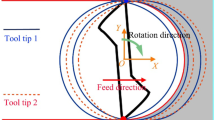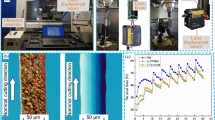Abstract
Optical glass is an isotropic amorphous solid material; due to its excellent performance, it has been widely used in various fields. However, during the milling process, the optical glass will have defects such as edge break damage and cracks on the surface, import and export, and side edges; these defects seriously affect the application of optical glass. In order to study the formation mechanism of defects such as edge break damage and cracks during optical glass processing and experimental and theoretical study of optical glass milling using ultrasonic vibration-assisted milling (UVAM), the edge break damage depth model of the export edge collapse was established. The results show that the main reason for the edge break damage is that the optical glass will crack on the subsurface during processing; the propagation of these cracks causes the amorphous material to tear and crumble. By comparing and analyzing the results of ultrasonic vibration milling and ordinary milling, ultrasonic vibration can significantly reduce this phenomenon, and it is found that the cutting depth and feed per tooth have a great influence on the export edge break damage value, and the influence of spindle speed is less. In addition, when the amplitude of the ultrasonic wave is applied, not only the import and export edge break damage phenomenon can be significantly improved, but also the surface quality can be significantly improved. Therefore, the application of ultrasonic vibration-assisted milling to the processing of optical glass can improve the surface and edge quality, which is help improve the application range of optical glass.












Similar content being viewed by others
Data availability
Not applicable.
Code availability
Not applicable.
References
O’Toole L, Kang C, Fang F (2019) Advances in rotary ultrasonic-assisted machining. Nanomanufacturing Metrol. https://doi.org/10.1007/s41871-019-00053-3
Kim T, Kwon K-K, Chu CN, Song KY (2020) Experimental investigation on CO2 laser-assisted micro-slot milling characteristics of borosilicate glass. Precis Eng 63:137–147. https://doi.org/10.1016/j.precisioneng.2020.02
Zhao PY, Zhou M, Liu XL, Jiang B (2020) Effect to the surface composition in ultrasonic vibration-assisted grinding of BK7 optical glass. Appl Sci 10(2):516. https://doi.org/10.3390/app10020516
Liu J, Chen G, Ren C, Qin X, Zou Y, Ge J (2020) Effects of axial and longitudinal-torsional vibration on fiber removal in ultrasonic vibration helical milling of CFRP composites. J Manuf Process 58:868–883. https://doi.org/10.1016/j.jmapro.2020.08.071
Verma GC, Pandey PM (2018) Machining forces in ultrasonic-vibration assisted end milling. Ultrasonics. https://doi.org/10.1016/j.ultras.2018.07.004
Sui H, Zhang X, Zhang D, Jiang X, Wu R (2017) Feasibility study of high-speed ultrasonic vibration cutting titanium alloy. J Mater Process Technol 247:111–120. https://doi.org/10.1016/j.jmatprotec.2017.03.017
Baraheni M, Amini S (2019) Predicting subsurface damage in silicon nitride ceramics subjected to rotary ultrasonic assisted face grinding. Ceram Int 45(8):10086–10096. https://doi.org/10.1016/j.ceramint.2019.02.055
Chen Y, Su H, Qian N, He J, Gu J, Xu J, Ding K (2021) Ultrasonic vibration-assisted grinding of silicon carbide ceramics based on actual amplitude measurement: grinding force and surface quality. Ceram Int 47(11):15433–15441. https://doi.org/10.1016/j.ceramint.2021.02.109
Jia D, Li C, Zhang Y, Yang M, Zhang X, Li R, Ji H (2019) Experimental evaluation of surface topographies of NMQL grinding ZrO2 ceramics combining multiangle ultrasonic vibration. Int J Adv Manuf Technol 100(1):457–473. https://doi.org/10.1007/s00170-018-2718-y
Fang B, Yuan Z, Li D, Gao L (2021) Effect of ultrasonic vibration on finished quality in ultrasonic vibration assisted micromilling of Inconel718. Chin J Aeronaut 34(6):209–219. https://doi.org/10.1016/j.cja.2020.09.021
Yang Y, Yang M, Li C, Li R, Said Z, Ali HM, Sharma S (2022) Machinability of ultrasonic vibration assisted micro-grinding in biological bone using nanolubricant. Front Mech Eng 12:1–8. https://doi.org/10.1007/s11465-022-0717-z
Yan Y, Zhang Y, Zhao B, Liu J (2021) Surface formation and damage mechanisms of nano-ZrO2 ceramics under axial ultrasonic-assisted grinding. J Mech Sci Technol 35(3):1187–1197. https://doi.org/10.1007/s12206-021-0232-x
Esmaeilzare A, Rahimi A, Rezaei SM (2014) Investigation of subsurface damages and surface roughness in grinding process of Zerodur® glass–ceramic. Appl Surf Sci 313:67–75. https://doi.org/10.1016/j.apsusc.2014.05.137
Li HN, Yu TB, Zhu LD, Wang WS (2016) Evaluation of grinding-induced subsurface damage in optical glass BK7. J Mater Process Technol 229:785–794. https://doi.org/10.1016/j.jmatprotec.2015.11.003
Yao Z, Gu W, Li K (2012) Relationship between surface roughness and subsurface crack depth during grinding of optical glass BK7. J Mater Process Technol 212(4):969–976. https://doi.org/10.1016/j.jmatprotec.2011.12.007
Niu J, Zhao, & Gao. (2019) Investigation of cutting force in longitudinal-torsional ultrasonic-assisted milling of Ti-6Al-4V. Materials 12(12):1955. https://doi.org/10.3390/ma12121955
Huang C, Zhou M, Zhang H (2021) A cutting force prediction model in axial ultrasonic vibration end grinding for BK7 optical glass considering protrusion height of abrasive grits. Measurement 180:109512. https://doi.org/10.1016/j.measurement.2021.109512
Zhang C, Liang Y, Zhang T, Chen X, Zhao J, Yu T (2021) Study on machining BK7 optical glass by ultrasonic vibration-assisted polishing considering the micro-contact state of the abrasive particles with the workpiece. J Manuf Process 72:469–482. https://doi.org/10.1016/j.jmapro.2021.10.033
Ma YJ, Nie WZ, Lu JM, Chen H (2020) Study on surface quality of BK7 optical glass by longitudinal torsional composite ultrasonic vibration milling. Mater Sci Forum 984:51–57. https://doi.org/10.4028/www.scientific.net/msf.984.51
Jin X, Xie B (2015) Experimental study on surface generation in vibration-assisted micro-milling of glass. Int J Adv Manuf Technol 81(1–4):507–512. https://doi.org/10.1007/s00170-015-7211-2
Amin M, Yuan S, Israr A, Zhen L, Qi W (2017) Development of cutting force prediction model for vibration-assisted slot milling of carbon fiber reinforced polymers. Int J Adv Manuf Technol 94(9–12):3863–3874. https://doi.org/10.1007/s00170-017-1087-2
Gong H, Fang FZ, Zhang XF, Du J, Hu XT (2013) Study on the reduction strategy of machining-induced edge chipping based on finite element analysis of in-process workpiece structure. J Manuf Sci Eng 135(1):011017. https://doi.org/10.1115/1.4023458
BrianLawn (2010) Fracture Mechanics of Brittle Solids:2 Edition [M]. Higher Education Press
Lambropoulos JC, Jacobs SD, Ruckman J (1999) Material removal mechanisms from grinding to polishing. Ceram Trans 102:113–128
Li ZC, Jiao Y, Deines TW, Pei ZJ, Treadwell C (2005) Rotary ultrasonic machining of ceramic matrix composites: feasibility study and designed experiments. Int J Mach Tools Manuf 45(12–13):1402–1411. https://doi.org/10.1016/j.ijmachtools.2005.01.034
Funding
This research is supported by the Doctoral Foundation of Henan Polytechnic University (Grant No. B2017-31) and the National Natural Science Foundation of China project “Research on subsurface damage mechanism of ceramic matrix composites machined by high speed multi-dimensional ultrasonic” (Grant No. 52005164).
Author information
Authors and Affiliations
Contributions
Jinglin Tong: Initial draft, funding acquisition.
Shuaikun Yang: Theoretical analysis, methodology.
Yanqiu Ye: Writing editing, paper format arrangement.
Zhipeng Zhang: Picture arrangement.
Chaosheng Song: Paper format arrangement.
Xiaobo Wang: Writing—review and editing.
Corresponding author
Ethics declarations
Ethics approval
Not applicable.
Consent to participate
Not applicable.
Consent for publication
Not applicable.
Conflict of interest
The authors declare no competing interests.
Additional information
Publisher's note
Springer Nature remains neutral with regard to jurisdictional claims in published maps and institutional affiliations.
Rights and permissions
Springer Nature or its licensor (e.g. a society or other partner) holds exclusive rights to this article under a publishing agreement with the author(s) or other rightsholder(s); author self-archiving of the accepted manuscript version of this article is solely governed by the terms of such publishing agreement and applicable law.
About this article
Cite this article
Tong, J., Yang, S., Ye, Y. et al. Edge breakage mechanism of optical glass surface in ultrasonic vibration-assisted milling. Int J Adv Manuf Technol 131, 2265–2278 (2024). https://doi.org/10.1007/s00170-023-11093-x
Received:
Accepted:
Published:
Issue Date:
DOI: https://doi.org/10.1007/s00170-023-11093-x




